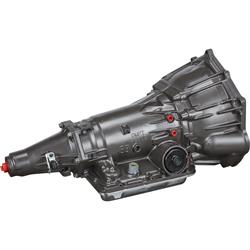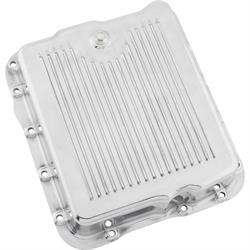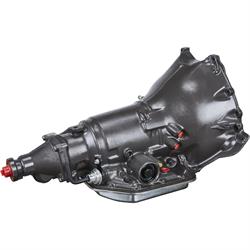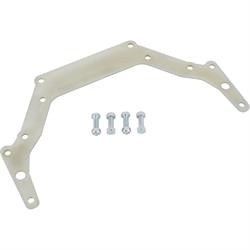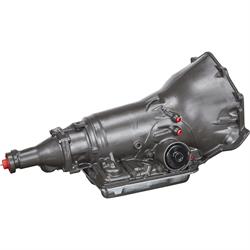How to Identify GM Transmissions | 700R4, TH350, 4L60, & More
Whether you just picked up a project car and need to know what transmission is in it, or you’re at the swap meet and want to be sure that transmission is what the seller says it is, the easiest way of identifying GM transmissions is by checking the shape of the pan. Below is a GM transmission identification chart that shows the pan shape of most common GM automatics.
GM Transmission Pan Identification Chart | Cheat Sheet
Chevy Transmission Codes | Decode Your GM Transmission
In our experience, we most often find ourselves looking at a GM transmission and simply wanting to know what it is and whether it’s the type we want to use for whatever project we’re planning. We have found that the best way to do this is to just use the GM transmission pan identification cheat sheet above. However, if you want to dig deeper into Chevy transmission identification and find out what car the transmission may have come from, when it was made, or whether it’s the “numbers matching” transmission for your car, you can start digging for the numbers stamped into the case or the riveted-on ID tag.
These numbers usually include a partial VIN from the car or truck the transmission was originally installed in stamped into the case, as well as additional GM transmission ID codes. This will be in various places, but you can usually start looking just above the pan rail on either the passenger or driver side. It can also be found on the bellhousing or near the shifter shaft. Conventions and systems changed throughout the years, so finding the number (if it’s still there) can be tricky. Here’s a rough guide to get you started.
Powerglide ID Numbers:
Earlier transmission ID numbers contained the code for the plant where it was produced, followed by a numerical date, then a “D” for day shift, “N” for night shift. See example below:
- C531D – Cleveland plant, May 31st, day shift
After 1967 the convention changed to include the transmission type or plant prefix, followed by a date now expressed with a letter for the month, followed by the day. For example:
- P9E31 – P (Powerglide), 9 (1969), E (month: May), 31 (Day of Month)
Month code: A = Jan, B = Feb, C = Mar, D = Apr, E = May, H = Jun, K = Jul, M = Aug, P = Sep, R = Oct, S = Nov, T = Dec
TH350 ID Numbers:
On a TH350, look for the stamped partial VIN on a pad somewhere around the bellhousing. The portion on the transmission will include a number indicating the division, followed by the last number of the year, a letter indicating the assembly plant, and then six digits indicating the car’s serial number. For example:
- 16B123456 – 1 (Chevrolet), 6 (1976 or 1986), B (Baltimore), 23456 (serial number)
TH400 ID Numbers:
TH400 transmissions should carry the same partial VIN as the TH350, but on a TH400 look for it stamped into the pan rail on the driver side, just behind the shifter shaft. This code can be translated as described for the TH350. Additionally, many TH400 transmissions were equipped with an ID tag riveted to the passenger side of the transmission which, if it’s still in place and legible, can reveal some interesting information.
In the 1970 tag example above – C (Chevrolet), R (engine, in this case 454), 324 (324th day of the production year), 1234 (serial number)
700R4 ID Numbers:
Some 700R4 transmissions have an ID sticker on top of the bellhousing. If you’re trying to ID 700R4 numbers and the sticker is missing, look for a stamped number toward the rear of the passenger side of the pan rail. The example in the photo a few sections up breaks down like this:
- 0FAM-Y-01353727-169B - 0 (1990), FA (model), M (700R4), Y (Toledo plant), 01353727 (serial number), 169 (Julian date), B (first shift)
4L60E ID Numbers:
4L60E transmissions left the factory with an ID sticker on top of the bellhousing. Since many of these transmissions are now more than 25 years old, that sticker is often gone or illegible. ’93-’97 4L60E transmission cases will also have an ID number stamped in the same spot as a 700R4, on the right rear side of the pan rail. ’96 and up 4L60E cases will have that ID number stamped on the bottom, just in front of the tailshaft housing. Whether you’re looking at the sticker or the stamped number, the number will follow this formula:
- 3KCDY12345678 - 3 (year: 1993 or 2003), KC (engine, in this case 5.3), D (transmission type, 4L60E), Y (manufacturing plant, in this case Toledo), 12345678 (serial number)
4L80E ID Numbers:
Like its TH400 predecessor, the 4L80E also should have a riveted on ID tag on the passenger side of the transmission. The year and Julian date are stamped into the tag.
In the example above, our 4L80 is a 1994. The photo above is also a good example of the way these ID numbers and tags can be damaged over the years. In this case, the transmission was painted and the tag was painted over. While we were still able to ascertain the year and day, pristine 4L80E tags also include letters indicating the model and a “P” indicating the 4L80E transmission type. Since these letters are painted on the tag, they are lost on our example.
This leads us to a couple caveats here. First, we’re talking about over five decades of transmission evolution, revolution, and changes in manufacturing technology and practices. As such, it’s hard for any list of numbers and locations to be comprehensive. Consider this a guide to help you start your journey if you need to dig deeper than a quick visual identification.
Secondly, many of these transmissions have lived some epic lives in those many decades since their manufacture. As evidenced by our 4L80E above, riveted tags get painted over, fall off, get bent up and broken, or are so covered in petrified ATF that they are illegible. Cases get blasted/smoothed when they are rebuilt or remanufactured. Some transmissions are built into aftermarket cases with visual differences as well as a lack of numbers. Of the half dozen transmissions that we pulled into the shop to reference for this article, only two still had a legible, useful number visible on the case.
700R4 Transmission ID | How to Identify a 700R4 Transmission
The 700R4 transmission was introduced in 1982 as an effort to make the old reliable TH350 more fuel efficient by adding a 30 percent overdrive to the top gear. They also have notoriously deep 3.06:1 first gears, and many of us remember Camaros and Caprices that would absolutely destroy the tires in low gear. Visually, a 700R4 is longer than a TH350 at around 30 inches, depending on the tailshaft housing, but the 700R4 bellhousing shares the one-piece design with the earlier transmissions. They also do not have vacuum modulators like the TH350 and TH400.
The old-school 700R4 has been installed in a lot of hot rods and classics over the years and it’s still a great transmission. In fact, there are even kits to adapt late model LS to 700R4 transmissions that may already be in the car.
4L60 Identification | Is a 4L60 the Same as a 700R4? | 4L60 vs. 700R4 Guide
This is where things get a little weird. In 1990 GM decided that it was tired of its former transmission naming convention, so the 700R4 was “rebranded” as a 4L60. “4” for 4-speed, “L” for longitudinal, and “60” as an indicator of torque handling (approximately what would be required for a vehicle with a 6,000-pound GVW). The newly named transmission still carried the same old TV cable and no electronics. This got confusing when the 4L60E was introduced in 1993. While still called a 4L60, the addition of the “E” meant that the old mechanically actuated throttle valve was replaced by an electronic interface with the car or truck’s computer.
4L60 vs 4L60e Identification
A 4L60E trans is easy to spot not only by its lack of a TV cable but also by the large 12-pin electrical harness connection on the right side of the transmission and a vehicle speed sensor on the tailshaft housing. The electronic control proved to be more reliable than the finicky TV cable and aftermarket standalone computers have made the 4L60E a favorite swap into older cars.
If you’re wondering how to identify a 4L60 transmission at a glance, note that there are three distinct eras of 4L60E. Those from 1993 to 1997 have a one-piece case, just like a 700R4. In 1996, the two-piece case was introduced, and in 2000 that separate bellhousing added a bolt hole in the 12 o’clock position and got ¾” deeper to accommodate a different input shaft and converter.
GM 4L80e Transmission ID | 4L60 vs 4L80 Identification
It’s commonly said that the 4L80E is the modern version of the TH400 with the extra benefit of an overdriven fourth gear. And in much the same way that you can differentiate a TH400 from a TH350 by just quickly glancing at the general size and visual “beefiness” of the cases, you can do the same to quickly tell a 4L80E from a 4L60. Another obvious visual 4L80E identification clue is that a 4L80 pan is absolutely enormous when compared to others like a 4L60 transmission pan. They’re bigger, stronger, and generally favored when serious power needs to go down to the ground. The 4L80 was introduced in GM trucks in 1991 and stayed in production until around 2009. Note that the transmission cooler line location changed around ‘97 with one outlet positioned much farther to the rear. Also, like the 4L60, later 4L80E bellhousings added a bolt hole in the 12 o’clock position.
One downside to a 4L80E is the beefy size that makes them, well, beefy. Sometimes some slicing and dicing will be necessary in older cars. A 4L80E mockup transmission will make that process much easier than wrestling an actual transmission around.
TH200 Transmission Identification | TH200 vs 2004R
The TH200 transmission was introduced in the mid 70’s following the OPEC embargo as a light duty, more efficient version of the TH350. These are visually similar to the TH350 and also have three forward gears. Also like the TH350, there were both TH200 transmissions with non-locking converters as well as TH200c variants with lockup converters. While there are exceptions, TH200 transmissions are best avoided for high performance, high horsepower applications.
The TH2004R was introduced in 1981 and added an overdrive to the light duty transmission. Unlike the TH200, these have developed strong aftermarket support due to their use in Turbo Regals and Turbo Trans Ams. It’s not uncommon for extremely modified Grand Nationals and T-Types to run into the 8’s with beefed-up 2004R transmissions. Most 2004R’s also have a unique bellhousing designed to work with both BOP and Chevy bolt patterns.
TH350 Transmission Identification
General Motors made approximately three bazillion TH350 transmissions from 1969 to around 1984. These things are everywhere, and they’re generally great transmissions for street and moderate performance use when an overdrive is not necessary. In addition to the pan shape, a TH350 transmission can be spotted by the kickdown cable that attaches right next to the dipstick on the passenger side. They also have a vacuum operated shift modulator near the tailshaft housing that TH350 and TH400 veterans will know well if they’ve ever had the vacuum line fall off and their car suddenly and mysteriously started lighting up the tires on the 1-2 shift.
TH350 vs TH400 Identification | TH400 ID
As we mentioned, in addition to the TH400 transmission pan having a unique shape, these two are easy to tell apart because the TH400 is visibly beefier than the TH350. TH400’s also use a unique electronic kickdown as opposed to the TH350’s manual cable. Generally speaking, the TH400 has a reputation for standing up to big power and abuse when compared to a TH350. They were commonly found behind big block engines in those legendary muscle cars of the 60's and early 70's as well as heavy duty trucks that were built for towing. They tend to rob a bit more power than a TH350 but the tradeoff is in their bulletproof performance.
It’s also important to note that both automatic transmission TH400 and TH350 variants were widely produced with both Chevy and BOP (Buick, Olds, Pontiac) bolt patterns. While BOP to Chevy adapters are available to adapt from one to the other, pay attention to this so you don’t end up with the wrong bellhousing bolt pattern.
Powerglide Transmission Identification
Here’s one for your next trivia night. The first mass-produced car with a fully automatic transmission was the ’40 Oldsmobile. These Hydra-Matic transmissions became the basis for the hopped up “Hydros” manufactured by companies like B&M for drag racing in the 60’s. Chevrolet joined the party in 1950 with its own Powerglide and it was a big deal, as evidenced by vintage newspaper clippings announcing the 2-speed Powerglide. These tough transmissions followed in the footsteps of the old Hydros and also became popular drag racing transmissions that are simple and strong when beefed up with widely available aftermarket Powerglide transmission parts. In 1962, GM started producing Powerglides with aluminum cases. Prior to this, ‘Glides used cast iron cases and were absolute tanks when it came time to pull one and move it around the shop. Both iron and aluminum versions are distinctive due to relatively compact cases that house only two forward gearsets and the Powerglide transmission pan appears to be “sideways” to those who are used to looking at more longitudinal pans.
Can VIN number tell transmission type? | How to tell what transmission is in a Chevy by VIN?
Generally, GM transmission identification by VIN is tricky because the VIN number on classic GM cars and trucks will not tell exactly what transmission was installed. However, it will offer clues that allow you to work backwards if you know what transmissions were and weren’t available with various combinations. In fact, as discussed above, the inverse is true of GM automatics; a partial VIN is often stamped into the transmission.
If you’re trying to figure out what transmission is in, or is supposed to be in your car, your best bet is to look for the Service Parts Identification sticker, usually inside the glovebox, that lists the RPO codes. Look for a code starting in “M” to find the transmission code. Note that all transmission RPO’s start with M, but not all M codes pertain to the transmission.
There are a zillion GM transmission RPO codes, so we’re not even going to attempt a comprehensive list. Start with what you find on your SPID sticker and a quick search of the internet should turn up what you’re looking for. However, note that many RPO codes (like “MX1” in our squarebody pictured above) indicate something like “3-speed automatic” without specifically stating TH350, TH400, etc.
As it often does with other power and drivetrain components, GM did enthusiasts a favor by keeping its automatic transmission designs fairly consistent across the decades. That means that in most cases, once you’ve confirmed what transmission design you’re working with, aftermarket parts fitment and adaptation to the chassis, engine, and driveshaft should be fairly straightforward. It’s also typically easy to swap from one GM automatic to another, and our Chevy transmission interchange chart will help with that process.

